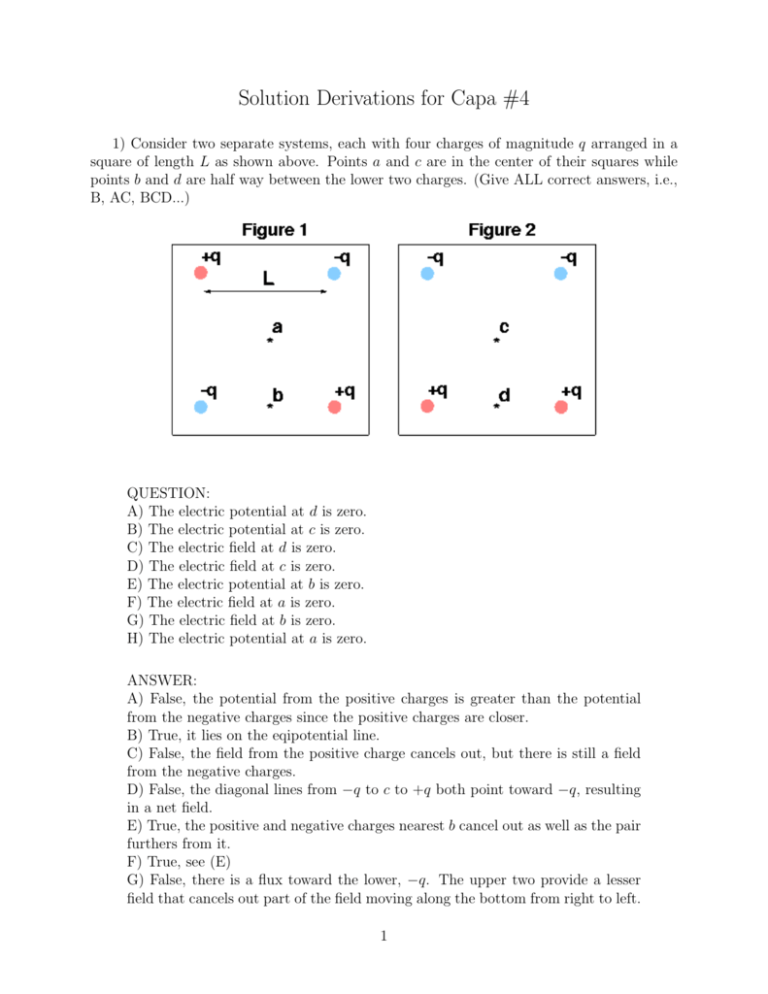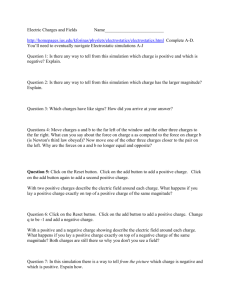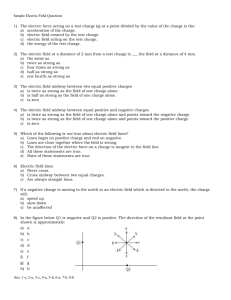Solution Derivations for Capa #4
advertisement

Solution Derivations for Capa #4 1) Consider two separate systems, each with four charges of magnitude q arranged in a square of length L as shown above. Points a and c are in the center of their squares while points b and d are half way between the lower two charges. (Give ALL correct answers, i.e., B, AC, BCD...) QUESTION: A) The electric potential at d is zero. B) The electric potential at c is zero. C) The electric field at d is zero. D) The electric field at c is zero. E) The electric potential at b is zero. F) The electric field at a is zero. G) The electric field at b is zero. H) The electric potential at a is zero. ANSWER: A) False, the potential from the positive charges is greater than the potential from the negative charges since the positive charges are closer. B) True, it lies on the eqipotential line. C) False, the field from the positive charge cancels out, but there is still a field from the negative charges. D) False, the diagonal lines from −q to c to +q both point toward −q, resulting in a net field. E) True, the positive and negative charges nearest b cancel out as well as the pair furthers from it. F) True, see (E) G) False, there is a flux toward the lower, −q. The upper two provide a lesser field that cancels out part of the field moving along the bottom from right to left. 1 H) True, a is equal distance from each point charge. As such, the potential sums to zero. Remember that potential is a scalar and electric field is a vector. CAPA is also looking for the letters of the correct answer, in this case, BEFH 2) Using the diagram above, find the magnitude of the electric field at point d. DATA: q = 0.750 µC, L = 0.40 m. q = Given L = Given . Since the field due to the positive The magnitude of the electric field is E = kq r2 point charges will cancel each other and the horizontal components of the negative point charges will also cancel, only the vertical component of each negative point charge contributes to the field. The field due to the vertical component will be E = kq cos θ. Since there are two negative charges, the electric field is twice that r2 from one charge, kq E = 2 2 cos θ r r is found from the right triangle shown, and cos θ can also be calculated from the picture. Thus, kq E = 2 L2 + = L 2 r L 2 L2 + 2 L 2 2kqL L2 + 2 32 L 2 3) The figure below shows two points in an E-field: Point 1 is at (X1 , Y1 ) = (3, 4) in m, and Point 2 is at (X2 , Y2 ) = (12, 9) in m. The Electric Field is constant, with a magnitude 2 of 80 V /m, and is directed parallel to the +X-axis. The potential at point 1 is 1000 V . Calculate the potential at point 2. P1 = (x1 , y1 ) = Given P2 = (x2 , y2 ) = Given E = Given V1 = Given First find the distance the point moved parallel to the electric field. Since the electric field is conservative, it does not matter how you get from point A to point B. The only thing that matters is the net distance you move parallel to the field in between. This distance is probably d = x2 − x1 . Since the electric field is constant, the equation for ∆V becomes ∆V = Z B A dV = − Z B E · dl = −E A Z B dl = −El A where the last steps follow because the displacement is in the same direction as the field. Thus, ∆V = −Ed This is the voltage change from point 1 to point 2. The potential at point 2 is V1 + ∆V . This will probably be less than the potential at point 1. 4) Calculate the work required to move a negative charge of Q = −562 µC from point 1 to point 2. In a constant electric field, the work is defined to be W = −qEl. Since you just calculated the potential (El) in the previous problem, this answer is just the charge times the field. (Watch the signs). 5) What is the electric field at the point x = 6.5 m? Positive E-fields point to the right. This problem only requires you to find the slope at the point given. However, from equation 25-10, the electric field is defined to be the negative of the slope of the potential graph. Contrary to the expected 1% margin of error you are given on the other problems, you always have to get graphs exactly. At least it seems that way. 6) The lines show the equipotential contours in the plane of three point charges, Q1 , Q2 , and Q3 . The values of the potentials are in kilovolts as indicated for the +5, 0, and -5 kV contours. The positions of the charges are indicated by the dots. (Give ALL correct answers, i.e., B, AC, BCD...) QUESTION: A) Charge Q3 has the largest magnitude of all. B) Charge Q2 is the largest negative charge. C) Q1 is a negative charge. 3 D) The electric field at i is stronger than at j. E) The electric field at k is zero. F) The force on a proton at g points to the bottom of the page. ANSWER: A) True, as shown on a concept test, Q3 has the largest magnitude potential at the farthest distance from itself making it the largest charge. B) False, the first eqipotential ring around Q1 has greater radius. C) True, negative potentials surround negative charge. D) True, i is closer to a charge than is j so it has a larger potential. E) False, the potential is not the field. The field describes the change in potential and although the potential is instantaneously zero at k, the field is not. (Sum the vectors from the point charges for proof). F) False, a proton will want to move away from the positive charge near the bottom of the page; thus the force would be toward the top. 4 7) Calculate the work required to move a charge of −0.39 × 10−12 C from ‘i’ to ‘b’. q = Given Two points given Work is defined as −W = qEl. But El is just the negative of the change in voltage. That is, −W = −q∆V W = q∆V Where ∆V is the potential difference between the two potential lines each point lies on. 8) Calculate the magnitude of the electric field at ‘k’. The electric field is given as E=− dV dl which can be approximated as E=− ∆V ∆l Thus, find the potential difference between the two potential lines nearest to the point requested and measure the distance between them. Only measure the distance perpendicular to both (that is, along a line that perpendicularly intersects each nearby curve). The letter should be somewhere near where that line will be. Remember to convert the distance to meters, and plug in the equation. 9) Calculate the magnitude of the force on a charge of 9.60 × 10−19 C at ‘g’. q = Given Force is equal to F = qE Although it would be nice to think we could use the electric field calculated in part (8), we can’t. Thus, you must get the ruler back out and calculate the field through this point in the same way as the last point. Then multiply by the charge. 10) Calculate the magnitude of Q3 . The magnitudes of the three charges are in the exact rations of 1 to 2 to 3. 5 To find the magnitude of Q3 you can pick a point on the graph (preferably on one of the equipotential lines) and calculate the potential at that point. Then, we can solve for Q. I chose a point on the +5 kV equipotential. Thus, the sum of potentials from each other charge had to add up to 5000 V on that line. That is, V1 + V2 + V3 = 5000 Since the magnitude of the charges are in the ratio of 1:2:3 (for the point charges 2, 1, and 3, respectively) Q1 = −2Q Q2 = −Q Q3 = 3Q Thus, 2kQ kQ 3kQ − + = 5000 r1 r2 r3 2 1 3 kQ − − + = 5000 r1 r 2 r3 − Q = 5000 k − r21 − 1 r2 + 3 r3 When measuring r1 , r2 , and r3 , remember to measure them along the perpendicular line connecting the two equipotential lines. Since it takes no work to move along an eqipotential, the only distance that matters is that along the perpendicular line. Also remember that the question asked for the charge on Q3 which has charge 3Q. 11) In the picture below, the 3 charges Q1 , Q2 , and Q3 are located at positions (−a, 0), (a, 0), and (0, −d) respectively. (The origin is the point halfway between Q1 and Q2 .) 6 Consider the special case where Q1 , Q3 > 0, and Q2 = −Q1 . Assume that the zero of potential is at infinity, as is normal for point charges. Which of the following statements are true? (Choose all correct answers e.g. ABD, CDFG). QUESTION: A) The electric field at the origin points in the positive y direction, away from Q3 . B) The force on Q3 due to the other two charges is zero. C) The external work done to bring these charges to this configuration (from infinity) was positive. D) The electric potential at any point along the y-axis is positive. E) The electric potential at the origin equals Q3 / (4π0 d). F) The work required to move Q3 from its present position to the origin is zero. G) If Q3 is released from rest, it will initially accelerate to the right. ANSWER: A) False, it points into the first quadrant since the field vectors from Q1 and Q2 both point to the right. The field from Q3 points up, but the resultant vector is not along the y-axis. B) False, the force points to the right. The vertical components of the force cancel, but their horizontal components add for the resultant force. C) False, it takes no work to bring the first charge in (Q1 ). It takes negative work to bring Q2 in since it is a negative charge being attracted to Q1 . Since this configuration is a dipole, it takes very little work to bring Q3 in perpendicular to the field (might be zero). Thus, the resulting work is negative. D) True, the potential from Q1 and Q2 cancel each other out leaving only the positive potential from Q3 . E) True, see (D) F) True, the work is W = −q∆V . Since the potential along the y-axis due to Q1 and Q2 is zero (it is only positive in (D) because of Q3 ), it takes no work to move Q3 along it. G) True, see (B) Remember to provide the letters of the correct answers, in this case, DEFG 12) In the previous problem, let Q1 = 2.10 µC, Q2 = −3.20 µC, and Q3 = 3.70 µC. (Note that Q1 and Q2 are different now.) The distances are a = 1.20 cm and d = 2.80 cm. Calculate the total electrostatic potential energy of the charge configuration. Q1 = Given Q2 = Given Q3 = Given a = Given d = Given 7 To find the “electrostatic potential energy” of the configuration, simply calculate the amount of energy required to bring the charges to their present position from infinity. It takes zero work to bring in the first charge (Q1 ). To bring in Q2 a distance 2a from Q1 , from equation 25-1, ∆UA→B = − Z B F · dl = − Z 2a ∞ A kQ1 Q2 dr r2 ∞ dr = kQ1 Q2 2a r 2 ∞ kQ1 Q2 = − r 2a Z kQ1 Q2 kQ1 Q2 = − − ∞ 2a ! kQ1 Q2 = − 0− 2a kQ1 Q2 = 2a ! To bring in the charge Q3 from infinity, we have to calculate the potential energy from both Q1 and Q2 that are already in place. Thus, ∆U = kQ1 Q3 kQ2 Q3 + r1 r2 r can be calculated from the triangle, r= √ a2 + d2 Thus, the total electrostatic potential energy is ∆U = kQ Q kQ1 Q2 kQ1 Q3 √ 2 3 +√ 2 + 2a a + d2 a2 + d2 8









